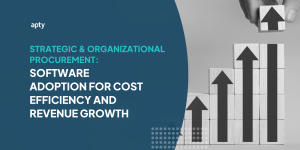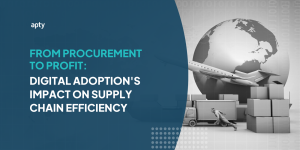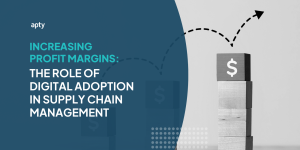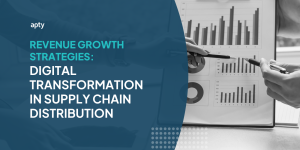Over the past few years, one trend that has emerged as a game-changer is the adoption of cloud initiatives. Cloud computing has transformed organizations’ operations, offering scalability, flexibility, and cost-efficiency like never before.
In an era of digital transformation, adopting cloud initiatives stands out as a significant turning point for businesses globally. By 2021, over 90% of enterprises will rely on a multi-cloud strategy. Cloud computing’s undeniable advantages – scalability, flexibility, and cost-efficiency – have positioned it as the tech sphere’s most compelling trend. Enter “Digital Adoption Platforms (DAPs),” a bridge between technology and its users, ensuring companies make the most of their cloud-driven transformations.
As this trend gains traction, the digital adoption platform emerges as the linchpin, ensuring companies harness the full power of their digital investments. But why are cloud initiatives capturing the corporate imagination? And how does DAP fit into this narrative?
In this blog, we will delve deep into the realm of “Cloud Initiatives,” explore the concept of “Digital Adoption Platforms (DAPs),” and understand how they can play a pivotal role in maximizing your Return on Investment (ROI).
The Rise of Cloud Initiatives

In recent years, cloud initiatives have risen to the forefront of organizational strategies, reshaping the technological landscape and revolutionizing how businesses operate. But what is Cloud Initiatives?
Cloud initiatives refer to the strategies and actions taken by organizations to leverage cloud computing technology to achieve business goals. Cloud initiatives can include migrating applications and data to the cloud, optimizing cloud usage for cost savings, and developing new products and services using cloud technology.
According to a survey, optimizing the existing use of clouds for cost savings is a priority for cloud initiatives for 61% of respondents in 2021, followed by migrating more workloads to the cloud.
These initiatives have gained prominence for several compelling reasons:
- Cost-Efficiency: Traditional IT infrastructure can be a significant drain on resources. With Cloud initiatives, organizations can save substantial amounts on hardware, maintenance, and energy costs. This financial flexibility allows businesses to allocate resources strategically and invest in other critical growth areas. According to Gartner, enterprise IT spending on public cloud computing within addressable market segments will overtake spending on traditional IT in 2025, and 51% of IT spending in these four categories will have shifted from traditional solutions to the public cloud by 2025. The shift from traditional IT infrastructures to cloud systems isn’t just about changing platforms – it’s a financial decision. By shifting to cloud solutions, companies can save up to 20-40% on hardware alone.
- Scalability: Cloud services offer the flexibility to scale up or down based on business needs. This elasticity is a game-changer for companies with fluctuating workloads, as it allows them to adapt swiftly to changing market demands without the need for significant upfront investments. Take Netflix, for example. As a major streaming service, the company sees huge traffic surges during peak times. By utilizing Amazon Web Services (AWS), they can scale resources instantaneously, catering to millions of viewers without a glitch.
- Accessibility: Cloud-based solutions provide access to data and applications from anywhere, at any time. This accessibility promotes collaboration and remote work, a crucial factor in modern business. Teams can collaborate seamlessly across geographies, leading to enhanced productivity and efficiency. In the era of remote work, companies like Slack and Trello have used cloud infrastructure to offer teams 24/7 access to tools and data from anywhere, boosting productivity by as much as 20%.
- Security and Compliance: Many Cloud service providers invest heavily in security, ensuring data protection and compliance with industry regulations. This can significantly relieve businesses that handle sensitive information, reducing the risk of costly data breaches and legal repercussions. Once criticized for its security, Dropbox turned its reputation around by transitioning to a more secure cloud environment and ensuring GDPR compliance, showcasing its potential to bolster data security.
- Innovation: Cloud platforms regularly update and introduce new features, allowing organizations to stay on the cutting edge of technology without significant investments in research and development. This constant innovation keeps businesses competitive and enables them to offer new and improved customer services. Cloud platforms, like Azure, roll out over 1,000 new capabilities annually. This constant innovation empowers businesses like Adobe, which transitioned from traditional software to a cloud-based model, resulting in a 27% increase in year-on-year revenue.
Understanding Digital Adoption Platforms (DAPs)

Digital adoption platforms (DAPs) have gained prominence recently as businesses seek to make the most of their digital investments. DAPs are a crucial component in the digital transformation puzzle, aiding companies in adopting and maximizing the use of their software and cloud applications.
What are DAPs?
Digital adoption platforms are comprehensive solutions that seamlessly integrate new software and cloud-based applications into an organization’s workflow. They offer a range of features and capabilities to ensure a smooth transition and optimized usage:
- User Onboarding: DAPs guide users through onboarding, ensuring a smooth and efficient introduction to new cloud applications. This is particularly beneficial when integrating complex software, as it reduces the employee learning curve.
- In-App Guidance: They offer in-app tutorials, tooltips, and pop-ups, reducing the learning curve associated with new software. This real-time, contextual guidance ensures that users can make the most of the features at their disposal, enhancing their productivity.
- User Engagement: DAPs engage users through contextual messaging and personalized experiences, increasing user satisfaction and retention. DAPs foster a sense of ownership and proficiency by tailoring the user experience to individual preferences and needs.
- Data Analytics: DAPs provide insights into user behavior and application usage, enabling data-driven decisions for improving user adoption. Organizations can gain valuable insights into user preferences, pain points, and areas that require further training or enhancement.
The Role of DAPs in Cloud Initiatives

Accelerating User Adoption
Cloud initiatives often involve deploying new software and tools, which can be met with resistance and reluctance from employees accustomed to older systems. DAPs, however, bridge this adoption gap by guiding users through the transition. They provide step-by-step instructions and in-app support, ensuring employees adapt quickly to these changes. This minimizes resistance and maximizes productivity from the outset, accelerating the realization of ROI.
During its rapid expansion amidst the remote work boom, Microsoft Teams utilized DAP features to onboard millions of users, ensuring they could utilize the platform effectively from day one.
Maximizing ROI
The success of any cloud initiative hinges on efficiently utilizing the deployed tools. While cloud solutions inherently offer cost savings and efficiency improvements, ensuring employees utilize these tools to their full potential is crucial.
DAPs actively assist users in making the most of these tools, thereby increasing the ROI. By providing ongoing training and support within the application, DAPs empower employees to unlock the full value of cloud-based software, leading to a more substantial return on investment.
SAP, integrating DAPs, saw a 30% increase in task completion rates within their software, translating directly to improved ROI for businesses utilizing their platforms.
Reducing Support Costs
When users encounter challenges or have questions about new software, they often contact the IT support team for assistance. This can lead to a significant increase in support requests, consuming valuable IT resources and time.
DAPs, however, help users find solutions independently. Users can troubleshoot issues independently through in-app guidance and self-service capabilities, reducing the burden on IT support and associated costs. This shift towards self-sufficiency saves resources and results in a more efficient and empowered workforce.
With the implementation of DAPs, Zendesk observed a 15% decrease in support ticket volume as users found solutions independently.
Ensuring Consistency
Consistency is paramount in ensuring data integrity and security. When employees use cloud applications in a consistent manner, it becomes easier to maintain data accuracy and compliance with regulatory requirements. DAPs ensure that all users follow best practices and use applications consistently. They provide guidance on standardized workflows and processes, reducing the risk of errors and ensuring that data remains reliable. This consistency is vital for organizations operating in highly regulated industries, where compliance and data security are non-negotiable.
In the medical sector, where patient data consistency is critical, platforms like Epic Systems utilize DAPs to ensure healthcare professionals input data correctly and consistently.
Realizing Revenue Opportunities with DAPs

One of the most significant advantages of incorporating a digital adoption platform into your cloud initiatives is the potential for realizing revenue opportunities. DAPs contribute to revenue generation in several ways:
Enhanced Customer Experience
Cloud-based applications often serve as touchpoints with customers. When your employees are adept at using these tools, they can deliver a superior customer experience. This enhanced customer experience can translate into increased sales and customer loyalty. For example, a customer support team equipped with a digital adoption platform can efficiently resolve customer issues, resulting in higher satisfaction rates and repeat business.
For example, Zappos, leveraging DAPs, optimized its internal software to provide timely and efficient customer support, directly correlating to its well-renowned customer satisfaction.
Faster Time-to-Market
In today’s business world, getting products and services to market quickly is crucial for maintaining a competitive edge. Digital adoption platform accelerates the learning curve for new tools and technologies, ensuring that your teams can get up to speed faster. This, in turn, enables quicker product launches and revenue generation. Projects move forward with greater agility when employees can efficiently use the latest software and collaborate seamlessly.
Data-Driven Decision Making
DAPs provide valuable insights into user behavior. You can make informed decisions that drive revenue growth by leveraging this data. Businesses using big data have seen an 8% increase in profit and a 10% reduction in cost. For instance, you can identify which software application features are most used by customers and focus on enhancing those features to attract more business. Data-driven decision-making is essential for fine-tuning products and services to meet customer demands accurately.
Optimizing Processes
DAPs help optimize business processes by ensuring employees use cloud applications efficiently. Streamlined processes often result in cost savings and revenue generation. For example, a DAP can guide sales teams through the most effective sales processes, leading to higher conversion rates and increased revenue. Additionally, it can assist finance teams in managing invoicing and billing processes more efficiently, reducing the time it takes to collect payments and improving cash flow.
The Symbiotic Relationship of Cloud Initiatives and DAPs
Digital transformation, fueled by cloud initiatives and DAPs, promises continuous growth and adaptability.
- Continuous Learning: DAPs provide ongoing support, ensuring users keep pace with the fast-evolving digital tools and software updates.
- User Feedback Loops: DAP-enabled feedback mechanisms are vital for refining cloud tools in alignment with user preferences and needs.
- Adaptation to Changing Needs: The inherent flexibility of both cloud and DAP solutions ensures businesses remain agile and responsive to market changes.
- Measuring ROI: DAP analytics allow businesses to quantify the success of their digital strategies, ensuring investments are always results-oriented.
During this period of digital dominance, cloud initiatives have proven their mettle, offering businesses a competitive edge. However, integrating the digital adoption platform is non-negotiable to harness the cloud’s power truly. As organizations aim for cost-efficiency, growth, and unparalleled customer experiences, the synergistic relationship between cloud and DAPs will be the linchpin for success.
Navigate the tech landscape with the knowledge that cloud isn’t just about data storage and processing—it’s about holistic transformation. Partner cloud capabilities with DAPs and set your organization on a trajectory for unparalleled growth and success in the digital age. As Apty, a leader in digital adoption, we’ve witnessed firsthand the immense value this dynamic duo can bring. Ensure your cloud journey is fortified with DAPs, and position yourself as a frontrunner in the digital world.
.













